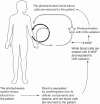Clinical Results of Extracorporeal Photopheresis
- PMID: 22969695
- PMCID: PMC3434329
- DOI: 10.1159/000341811
Clinical Results of Extracorporeal Photopheresis
Abstract
Extracorporeal photopheresis (ECP) is a combination of leukapheresis and photodynamic therapy in which blood is treated with photoactivable drugs which are then activated with ultraviolet light and re-infused to the patient. It has been used successfully for more than 30 years in the treatment of erythrodermic cutaneous T-cell lymphoma (CTCL) and over 20 years for chronic graft-versus-host disease (GVHD). ECP has also shown promising results in the treatment of acute GVHD and other T-cell-mediated diseases, including systemic sclerosis, treatment and prevention of solid organ rejection, and more recently Crohn's disease. The use of ECP may allow a significant reduction or even discontinuation of corticosteroids and/or other immunosuppressants, thus leading to reduced long-term morbidity and mortality and improved overall survival. ECP is a well-tolerated therapy. No significant side effects have been reported during the last 30 years. It has been shown that ECP is not associated with an increased incidence of infections, malignancies, or recurrence of underlying malignant disease, neither during short-term nor during long-term therapy.
Die extrakorporale Photopherese (ECP) ist eine Kombination aus Leukapherese und photodynamischer Therapie, bei der Blut mit photoaktiven Substanzen behandelt, mit ultraviolettem Licht bestrahlt und reinfundiert wird. Die ECP-Therapie wird seit 30 Jahren erfolgreich in der Behandlung von erythrodermen kutanen T-Zell-Lymphomen und seit 20 Jahren in der Behandlung von chronischer Graft-versus-Host-Erkrankung (GVHD) eingesetzt. Darüber hinaus konnten vielversprechende Ergebnisse in der Behandlung der akuten GVHD und anderer T-Zell-mediierter Erkrankungen einschließlich Systemischer Sklerose, Behandlung und Prävention von Abstoßungsreaktion nach Transplantation solider Organe und kürzlich auch bei Therapie des Morbus Crohn gezeigt werden. Der Einsatz von ECP erlaubt eine signifikante Reduktion oder sogar das Absetzen von Steroiden und/oder anderen immunsuppressiven Medikamenten, was zu einer Reduktion der Morbidität und Mortalität und zu einem verbesserten Gesamtüberleben führt. In den letzten 30 Jahren wurden keine signifikanten Nebenwirkungen der ECP berichtet. Es konnte gezeigt werden, dass die ECP weder bei kurzer, noch bei langer Anwendungsdauer mit einem erhöhten Risiko für das Auftreten von Infekten, Malignomen oder Rezidiv der zugrunde liegenden malignen Erkrankung vergesellschaftet ist.
Figures



Similar articles
-
Extracorporeal photopheresis: what is it and when should it be used?Clin Exp Dermatol. 2009 Oct;34(7):757-60. doi: 10.1111/j.1365-2230.2009.03475.x. Epub 2009 Jul 29. Clin Exp Dermatol. 2009. PMID: 19663836 Review.
-
Extracorporeal Photopheresis and Its Use in Clinical Dermatology in Canada.Skin Therapy Lett. 2022 Sep;27(5):1-6. Skin Therapy Lett. 2022. PMID: 36469458 Review.
-
Extracorporeal photopheresis: past, present, and future.J Am Acad Dermatol. 2009 Oct;61(4):652-65. doi: 10.1016/j.jaad.2009.02.039. Epub 2009 Aug 7. J Am Acad Dermatol. 2009. PMID: 19665258 Review.
-
The role of extracorporeal photopheresis in the management of cutaneous T-cell lymphoma, graft-versus-host disease and organ transplant rejection: a consensus statement update from the UK Photopheresis Society.Br J Haematol. 2017 Apr;177(2):287-310. doi: 10.1111/bjh.14537. Epub 2017 Feb 21. Br J Haematol. 2017. PMID: 28220931 Free PMC article.
-
Successful implementation of a rural extracorporeal photopheresis program for the treatment of cutaneous T-cell lymphoma and chronic graft-versus-host disease in a rural hospital.J Clin Apher. 2015 Dec;30(6):359-63. doi: 10.1002/jca.21382. Epub 2015 Feb 17. J Clin Apher. 2015. PMID: 25691106
Cited by
-
Effects of Extracorporeal Photopheresis on Quality of Life and the Course of Diseases in Patients With Mycosis Fungoides and Graft-Versus-Host Disease: A Single-Center Analysis.Cureus. 2023 May 12;15(5):e38929. doi: 10.7759/cureus.38929. eCollection 2023 May. Cureus. 2023. PMID: 37309341 Free PMC article.
-
Recommendations for Therapeutic Apheresis by the Section "Preparative and Therapeutic Hemapheresis" of the German Society for Transfusion Medicine and Immunohematology.Transfus Med Hemother. 2019 Dec;46(6):394-406. doi: 10.1159/000503937. Epub 2019 Nov 6. Transfus Med Hemother. 2019. PMID: 31933569 Free PMC article. Review.
-
A transition from using multi-step procedures to a fully integrated system for performing extracorporeal photopheresis: A comparison of costs and efficiencies.J Clin Apher. 2017 Dec;32(6):474-478. doi: 10.1002/jca.21542. Epub 2017 Apr 17. J Clin Apher. 2017. PMID: 28419561 Free PMC article.
-
Therapeutic Hemapheresis.Transfus Med Hemother. 2012 Aug;39(4):232-233. doi: 10.1159/000341819. Epub 2012 Jul 26. Transfus Med Hemother. 2012. PMID: 22969691 Free PMC article. No abstract available.
-
Pharmacological- and non-pharmacological therapeutic approaches in inflammatory bowel disease in adults.World J Gastrointest Pharmacol Ther. 2016 Feb 6;7(1):5-20. doi: 10.4292/wjgpt.v7.i1.5. World J Gastrointest Pharmacol Ther. 2016. PMID: 26855808 Free PMC article. Review.
References
-
- Edelson R, Berger C, Gasparro F, Jegasothy B, Heald P, Wintroub B, Vonderheid E, Knobler R, Wolff K, Plewig G, et al. Treatment of cutaneous T-cell lymphoma by extracorporeal photochemotherapy. Preliminary results. N Engl J Med. 1987;316:297–303. - PubMed
-
- Ward DM. Extracorporeal photopheresis: how, when, and why. J Clin Apher. 2011;26:276–285. - PubMed
-
- Schmitt S, Johnson TS, Karakhanova S, Naher H, Mahnke K, Enk AH. Extracorporeal photophoresis augments function of CD4+CD25+FoxP3+ regulatory T cells by triggering adenosine production. Transplantation. 2009;88:411–416. - PubMed
-
- Perseghin P, Dassi M, Balduzzi A, Rovelli A, Bonanomi S, Uderzo C. Mononuclear cell collection in patients undergoing extra-corporeal photo-chemotherapy for acute and chronic graft-vs.-host-disease (GvHD): comparison between COBE Spectra version 4.7 and 6.0 (AutoPBSC). J Clin Apher. 2002;17:65–71. - PubMed
LinkOut - more resources
Full Text Sources

